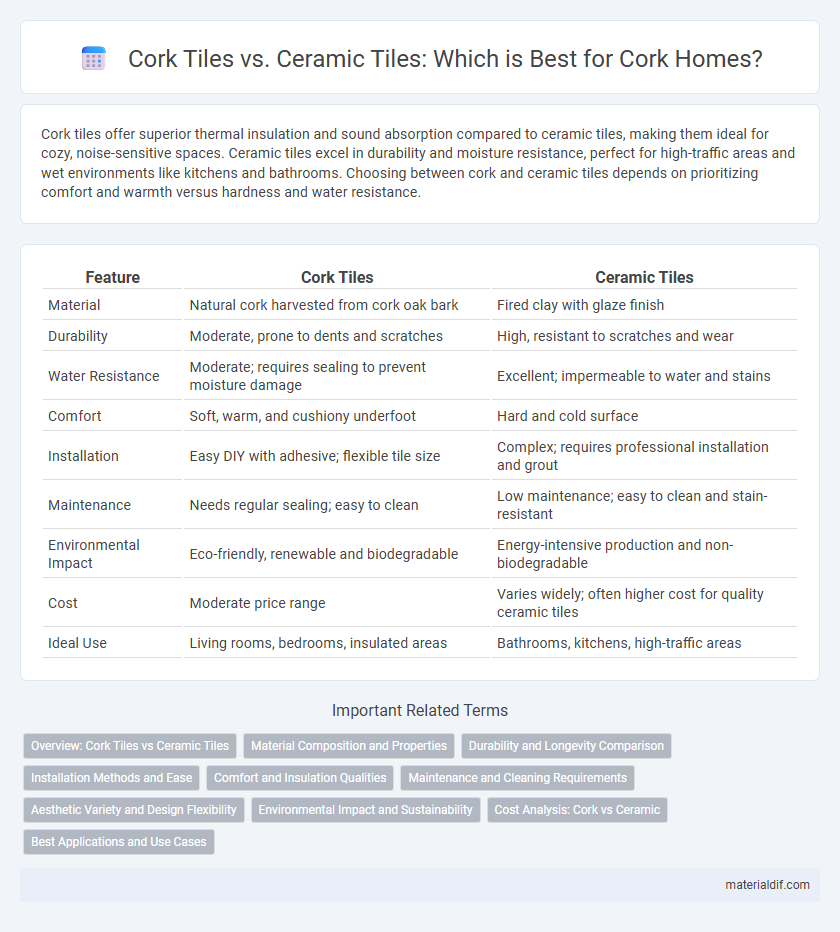Cork tiles offer superior thermal insulation and sound absorption compared to ceramic tiles, making them ideal for cozy, noise-sensitive spaces. Ceramic tiles excel in durability and moisture resistance, perfect for high-traffic areas and wet environments like kitchens and bathrooms. Choosing between cork and ceramic tiles depends on prioritizing comfort and warmth versus hardness and water resistance.
Table of Comparison
| Feature | Cork Tiles | Ceramic Tiles |
|---|---|---|
| Material | Natural cork harvested from cork oak bark | Fired clay with glaze finish |
| Durability | Moderate, prone to dents and scratches | High, resistant to scratches and wear |
| Water Resistance | Moderate; requires sealing to prevent moisture damage | Excellent; impermeable to water and stains |
| Comfort | Soft, warm, and cushiony underfoot | Hard and cold surface |
| Installation | Easy DIY with adhesive; flexible tile size | Complex; requires professional installation and grout |
| Maintenance | Needs regular sealing; easy to clean | Low maintenance; easy to clean and stain-resistant |
| Environmental Impact | Eco-friendly, renewable and biodegradable | Energy-intensive production and non-biodegradable |
| Cost | Moderate price range | Varies widely; often higher cost for quality ceramic tiles |
| Ideal Use | Living rooms, bedrooms, insulated areas | Bathrooms, kitchens, high-traffic areas |
Overview: Cork Tiles vs Ceramic Tiles
Cork tiles offer a natural, renewable material with superior insulation, sound absorption, and comfort underfoot compared to ceramic tiles, which are durable, water-resistant, and ideal for high-moisture areas. Cork tiles provide warmth and resilience but require more maintenance to protect against moisture and damage, while ceramic tiles excel in hardness and ease of cleaning, making them suitable for kitchens and bathrooms. The choice between cork and ceramic tiles depends on factors like desired aesthetic, room function, and environmental preferences in home or commercial flooring.
Material Composition and Properties
Cork tiles are made from the bark of cork oak trees, offering natural insulation, elasticity, and water resistance, making them soft underfoot and eco-friendly. Ceramic tiles are composed of clay and other inorganic materials, fired at high temperatures to create a hard, durable, and water-resistant surface ideal for high-traffic areas. Cork's thermal and acoustic insulation contrasts with ceramic's superior hardness and moisture resistance, influencing their application in various environments.
Durability and Longevity Comparison
Cork tiles offer superior resilience due to their natural elasticity, making them less prone to cracks and damage compared to ceramic tiles. Ceramic tiles, while harder and more resistant to scratches, may chip or crack upon heavy impact, affecting their overall durability. Cork's ability to absorb impacts and resist wear extends its longevity in high-traffic areas, whereas ceramic tiles require more maintenance to preserve their appearance and structural integrity over time.
Installation Methods and Ease
Cork tiles offer a straightforward installation process with peel-and-stick or click-lock systems, making them ideal for DIY projects due to their flexibility and lightweight nature. Ceramic tiles require precise surface preparation, mortar application, and grout curing, demanding specialized skills and tools for proper installation. The overall ease of installing cork tiles surpasses ceramic, especially where moisture resistance and thermal insulation are priorities.
Comfort and Insulation Qualities
Cork tiles offer superior comfort underfoot due to their natural cushioning properties, making them ideal for areas with prolonged standing. Their cellular structure provides excellent thermal and acoustic insulation, reducing heat loss and noise transmission more effectively than ceramic tiles. Ceramic tiles, while durable and easy to clean, lack the insulating benefits of cork and tend to feel colder and harder, impacting overall comfort.
Maintenance and Cleaning Requirements
Cork tiles require gentle cleaning with a damp mop and mild detergent to preserve their natural texture and are resistant to mold and mildew, making maintenance simple and eco-friendly. Ceramic tiles demand regular sweeping and occasional deep cleaning with pH-balanced cleaners to prevent grout discoloration and surface stains, which can be more labor-intensive over time. Cork's natural resilience and ease of upkeep often make it a preferred choice over ceramic in spaces prioritizing low-maintenance flooring.
Aesthetic Variety and Design Flexibility
Cork tiles offer unique natural textures and warm tones that create cozy, organic aesthetics, while ceramic tiles provide a vast range of colors, patterns, and finishes, from glossy to matte. Cork's flexibility allows for seamless integration in various room styles, enhancing acoustic and thermal properties, whereas ceramic tiles excel in detailed designs and intricate mosaics, perfect for contemporary and traditional looks. Both materials support creative flooring solutions, but ceramic tiles afford greater precision in patterns and glossy visual effects, while cork emphasizes comfort and eco-friendly appeal.
Environmental Impact and Sustainability
Cork tiles offer superior environmental benefits compared to ceramic tiles due to their renewable harvesting process, as cork is sustainably harvested from the bark of cork oak trees without harming them, ensuring continuous regrowth and carbon sequestration. Ceramic tiles require extensive mining of raw materials and high-temperature kiln firing, leading to greater carbon emissions and resource depletion. Cork's biodegradability and natural insulation properties contribute to reduced energy consumption and waste, making it a more sustainable flooring choice than traditional ceramic tiles.
Cost Analysis: Cork vs Ceramic
Cork tiles generally have a higher upfront cost compared to ceramic tiles, primarily due to their renewable harvesting process and natural sound insulation properties. Over time, cork tiles may offer cost savings through energy efficiency and durability, especially in areas where thermal insulation is valuable. Ceramic tiles, while cheaper initially and highly resistant to moisture and stains, may incur higher maintenance costs if cracked or chipped, impacting long-term expenses.
Best Applications and Use Cases
Cork tiles offer superior acoustic insulation and moisture resistance, making them ideal for residential flooring, yoga studios, and playrooms where comfort and sound dampening are priorities. Ceramic tiles excel in high-traffic areas such as kitchens, bathrooms, and commercial spaces due to their durability, stain resistance, and ease of maintenance. Choosing cork tiles enhances warmth and eco-friendliness, while ceramic tiles provide a long-lasting, water-resistant surface suitable for heavy use.
Cork Tiles vs Ceramic Tiles Infographic

 materialdif.com
materialdif.com